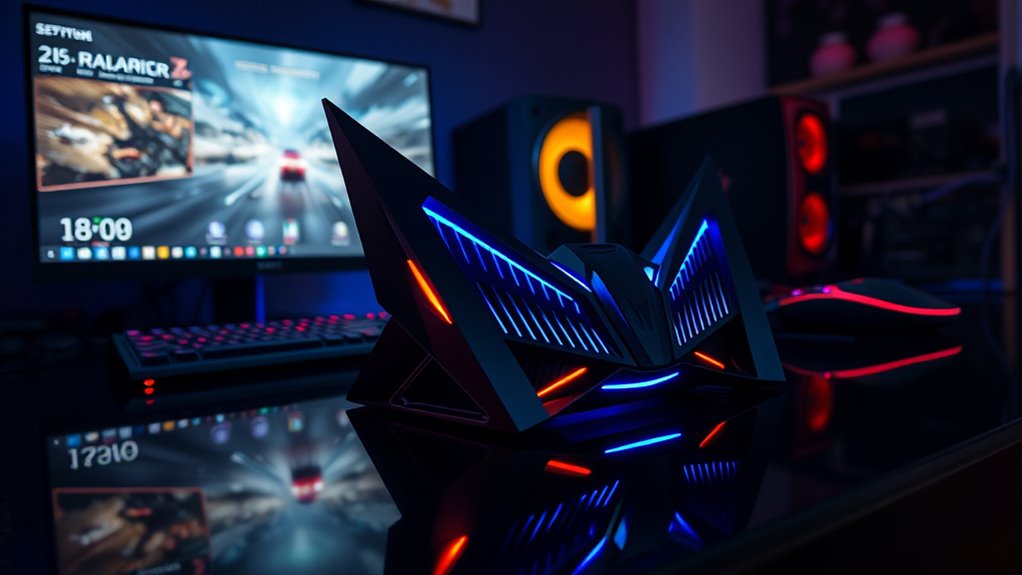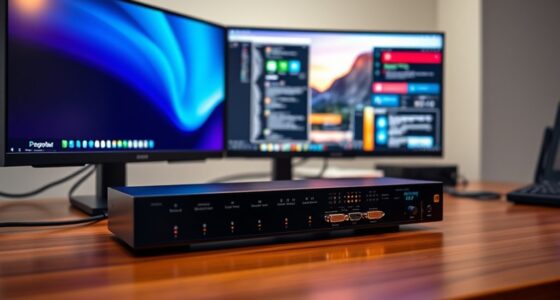If you want the best gaming experience in 2025, I recommend choosing high-performance routers like the TP-Link AXE5400 Tri-Band WiFi 6E, ASUS ROG Rapture GT-AX11000 Pro, or the latest WiFi 7 models from TP-Link and ASUS. These routers offer ultra-fast speeds, minimal lag, and strong coverage, even with multiple devices connected. If you keep exploring, I’ll help you find the perfect fit for your gaming setup and needs.
Key Takeaways
- High-speed WiFi 6, 6E, and WiFi 7 routers deliver ultra-fast connections up to 19 Gbps for seamless gaming.
- Advanced gaming features like dedicated ports, Game Acceleration, and AI QoS prioritize gaming traffic and reduce lag.
- Robust coverage with external antennas, beamforming, and mesh support ensures stable, low-latency connections across large spaces.
- Easy setup via apps and web interfaces with user-friendly management enhances gaming network reliability.
- Many models include security features, but firmware stability and software updates are crucial for optimal gaming performance.
TP-Link AXE5400 Tri-Band WiFi 6E Router
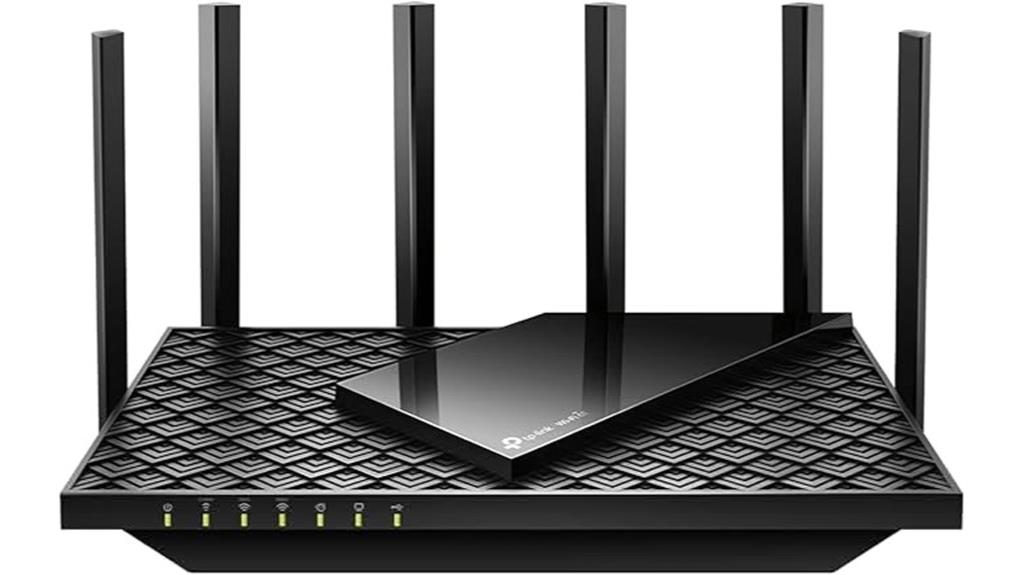
If you’re serious about gaming in 2025, the TP-Link AXE5400 Tri-Band WiFi 6E Router is a top choice because it leverages the latest WiFi 6E technology to deliver blazing-fast speeds and near-zero latency. With its tri-band setup, it offers up to 5400 Mbps, including a dedicated 6 GHz band for ultra-responsive gaming and streaming. OFDMA technology allows multiple devices to transmit simultaneously, reducing lag. Its high-performance hardware, including a 1.7 GHz quad-core CPU, ensures smooth operation even under heavy load. Plus, easy setup through the TP-Link Tether app and seamless mesh compatibility make it a reliable, future-proof option.
Best For: gamers and streaming enthusiasts seeking ultra-fast, low-latency WiFi coverage with future-proof technology.
Pros:
- Delivers up to 5400 Mbps speeds across tri-bands, ideal for gaming and streaming.
- Supports WiFi 6E with a dedicated 6 GHz band for minimal latency and interference.
- Easy to set up and manage via TP-Link Tether app, with seamless mesh compatibility.
Cons:
- May be overkill for basic internet needs or small households with fewer devices.
- Some older devices may not support WiFi 6/6E, limiting performance gains.
- Slightly higher cost compared to dual-band or WiFi 5 routers, though justified by advanced features.
TP-Link AX1800 WiFi 6 Router (Archer AX21)
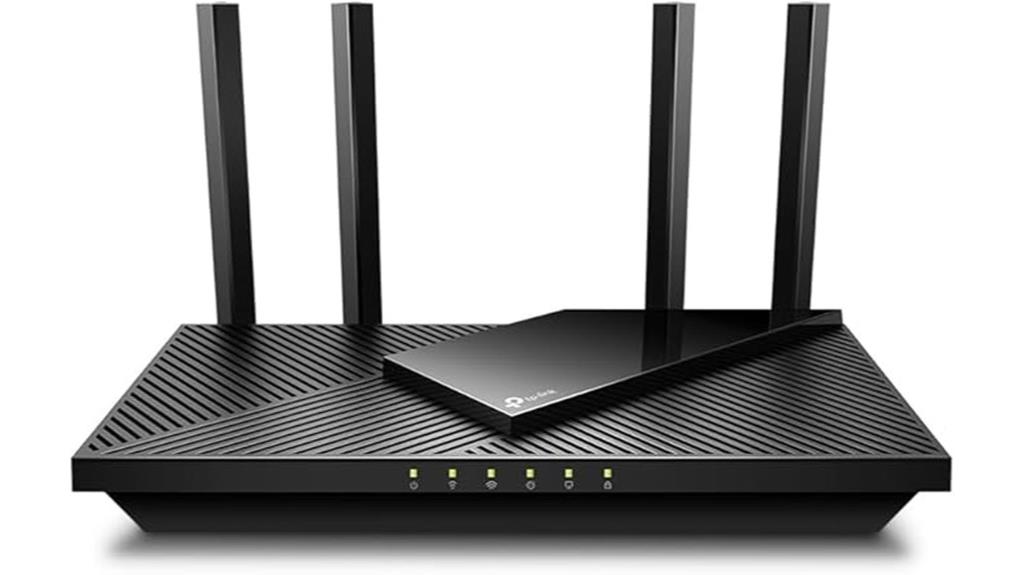
The TP-Link AX1800 WiFi 6 Router (Archer AX21) stands out as an excellent choice for gamers who need fast, reliable connections across multiple devices. It supports dual-band Wi-Fi 6, delivering speeds up to 1.8 Gbps—ideal for smooth gaming and streaming. With OFDMA and Beamforming technology, it manages many devices efficiently while providing strong, consistent coverage. Easy to set up via the app or web interface, it offers features like parental controls, guest networks, and VPN support for added security. Many users report significant speed boosts and improved stability, making it a cost-effective upgrade for enhancing home networks and minimizing lag.
Best For: gamers and households seeking fast, reliable, and extensive Wi-Fi coverage with easy setup and strong device management.
Pros:
- Supports Wi-Fi 6 with speeds up to 1.8 Gbps for smooth gaming and streaming
- Equipped with OFDMA and Beamforming technology for efficient device management and strong coverage
- Easy to set up via app or web interface, with customizable network options
Cons:
- Requires a compatible modem, which may add to initial setup costs
- Some advanced features may need manual configuration for optimal performance
- Limited to 2-year warranty, which is standard but shorter than some competitors
TP-Link AX6000 WiFi 6 Router
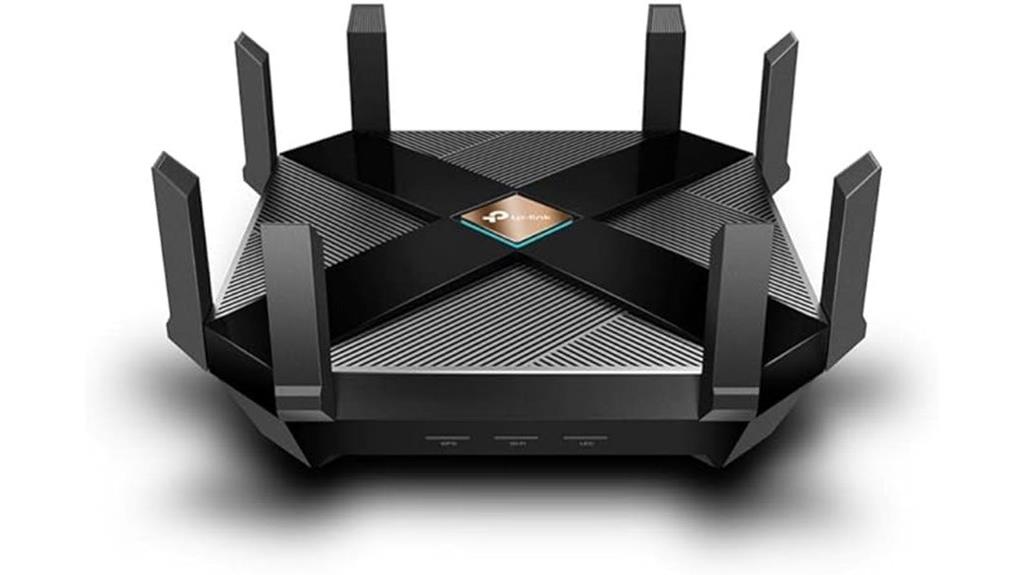
For gamers seeking a reliable, high-speed connection across a large home, the TP-Link AX6000 WiFi 6 Router stands out with its impressive combined speeds of up to 5952 Mbps and robust coverage. Its 8 external antennas, Beamforming, Range Boost, and BSS color tech deliver stable, long-range Wi-Fi with minimal interference. Powered by a 1.8 GHz quad-core CPU and co-processors, it handles many devices simultaneously using OFDMA and MU-MIMO. With 8 Gigabit LAN ports, a 2.5 Gbps WAN port, and USB 3.0 ports, it’s perfect for gaming, streaming, and smart devices. Easy to set up and compatible with major ISPs, it’s a top-tier choice for large homes.
Best For: gamers and large households seeking a reliable, high-speed Wi-Fi 6 router with extensive coverage and device capacity.
Pros:
- Exceptional Wi-Fi speeds up to 5952 Mbps and stable long-range coverage
- Advanced technologies like Beamforming, Range Boost, OFDMA, and MU-MIMO for efficient multi-device handling
- Easy setup with user-friendly app and seamless mesh networking support
Cons:
- Slightly bulky design that may require ample space for placement
- Premium price point compared to basic routers
- Occasional minor setup quirks such as hidden passwords may challenge some users
ASUS ROG Rapture GT-AX11000 Pro Gaming Router

With speeds reaching up to 11,000 Mbps and support for WiFi 6, WiFi 6E, and WiFi 7, the ASUS ROG Rapture GT-AX11000 Pro is a top-tier choice for serious gamers and high-demand households. Its tri-band setup, combined with ASUS RangeBoost Plus, expands coverage, while the 2.0 GHz quad-core CPU guarantees smooth multi-device performance. With features like MLO, Smart Connect, and extensive security options, it’s built for fast, reliable, low-latency connections. The stylish “spiderbot” design and customizable lighting add a premium touch, making it not just a powerhouse but also a centerpiece for any gaming setup.
Best For: gamers and high-demand households seeking ultra-fast, low-latency WiFi with extensive coverage and advanced security features.
Pros:
- Supports WiFi 6, 6E, and 7 for future-proof high-speed connectivity
- Tri-band setup with ASUS RangeBoost Plus for wide coverage
- Customizable lighting and high-end build quality suited for gaming environments
Cons:
- Requires internet access during setup, which may be limiting in some situations
- Short-range design means performance diminishes over distance and obstacles
- Premium price point may be prohibitive for casual users
ASUS RT-AX82U Dual Band WiFi 6 Gaming Router
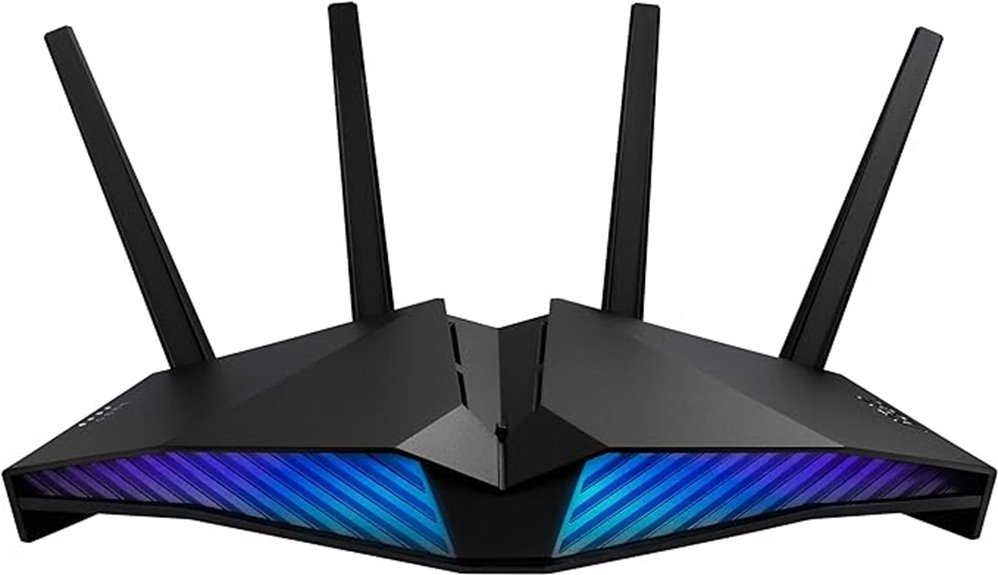
If you’re serious about gaming and need a router that can keep up with demanding setups, the ASUS RT-AX82U Dual Band WiFi 6 Gaming Router stands out as an ideal choice. It offers ultrafast speeds up to 5400 Mbps with WiFi 6, ensuring smooth gameplay, 4K streaming, and stable connections even during heavy traffic. It features a dedicated gaming port, ASUS Game Acceleration, and Mobile Game Mode to reduce lag and ping spikes. With Aura RGB lighting for style, AiMesh support for whole-home coverage, and robust security with free lifetime protections, this router combines performance, security, and sleek design for serious gamers.
Best For: gamers and home users seeking high-speed, reliable WiFi 6 performance with advanced gaming features and robust security.
Pros:
- Ultrafast speeds up to 5400 Mbps with WiFi 6 and 160MHz channels for seamless gaming and streaming
- Dedicated gaming port and ASUS Game Acceleration to prioritize gaming traffic and reduce lag
- AiMesh support and Aura RGB lighting add flexibility and aesthetic appeal
Cons:
- Initial setup can be complex, especially configuring security and guest networks
- Support and troubleshooting may be limited for some users
- Slightly higher price point compared to basic routers
NETGEAR Nighthawk Pro Gaming WiFi 6 Router (XR1000)
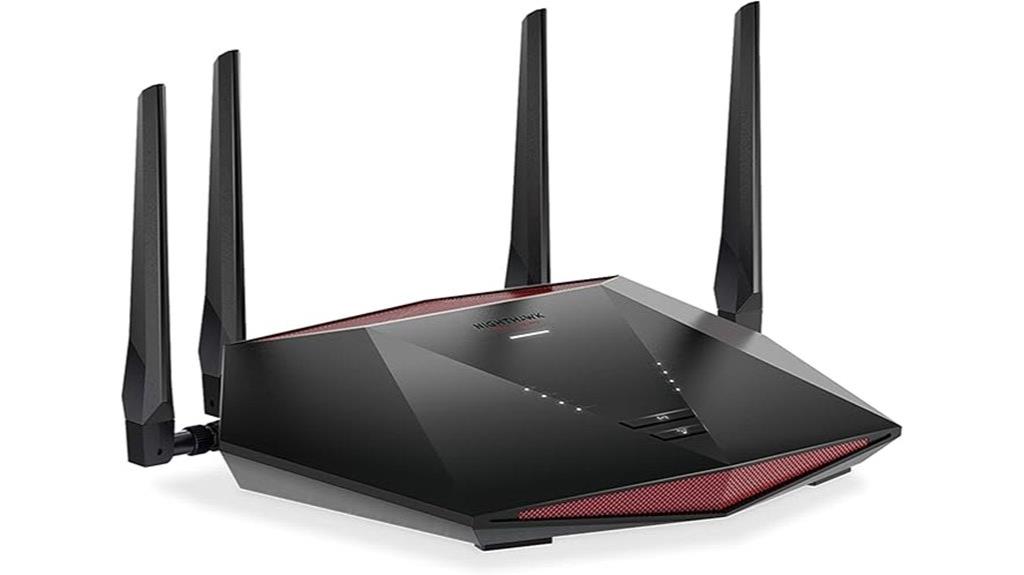
The NETGEAR Nighthawk Pro Gaming WiFi 6 Router (XR1000) stands out for gamers who demand ultra-fast, stable connections and advanced features to optimize their online experience. It delivers AX5400 dual-band WiFi 6 speeds up to 5.4Gbps and supports multiple devices simultaneously, reducing ping by up to 93% with DumaOS 3.0. Features like geo-fencing, ping heatmaps, and server filtering help minimize lag and improve gameplay. Equipped with four gigabit Ethernet ports and a USB 3.0 port, it works with wired and wireless devices. Despite impressive specs, some users report bugs and interface issues, which can impact overall usability.
Best For: gamers seeking ultra-fast, stable WiFi 6 connections with advanced tools to reduce lag and optimize gameplay, despite potential usability issues.
Pros:
- Supports WiFi 6 with speeds up to 5.4Gbps and supports multiple devices simultaneously
- Reduces ping by up to 93% with DumaOS 3.0, enhancing online gaming experiences
- Features geo-fencing, ping heatmaps, and server filtering for gameplay optimization
Cons:
- Reports of bugs, interface inconsistencies, and reliability problems affecting usability
- Limited customization and problematic network monitoring features
- Higher price point with some users considering it not worth the cost due to software flaws
TP-Link Tri-Band Wi-Fi 7 Gaming Router Archer GE650
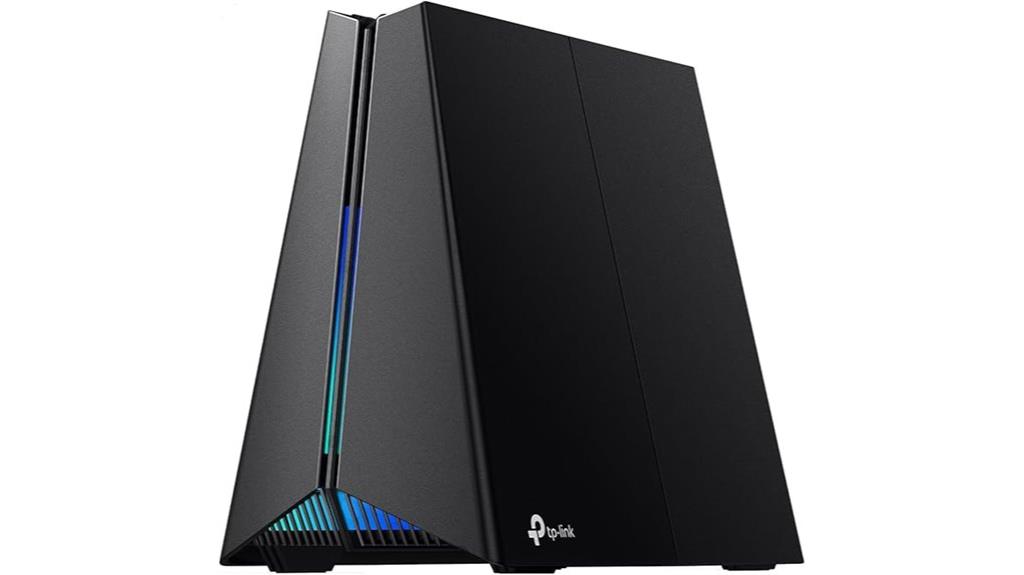
Gamers seeking lightning-fast speeds and stable connections should consider the TP-Link Tri-Band Wi-Fi 7 Archer GE650, especially since it leverages cutting-edge Wi-Fi 7 technology. It offers three bands—6 GHz, 5 GHz, and 2.4 GHz—delivering speeds up to 5764 Mbps on the 6 GHz band, ideal for gaming and streaming. Multi-Link Operation (MLO) enables simultaneous band use for reliable data transfer. The router also features multi-gig ports, including 5 Gbps WAN and LAN, plus 2.5 Gbps ports for wired devices. With gaming optimization, network management, and strong coverage, the Archer GE650 is a top choice for high-demand gaming setups, though performance dips beyond 10 feet are noted.
Best For: gamers and high-demand households seeking ultra-fast, stable Wi-Fi 7 connectivity with robust wired options.
Pros:
- Supports tri-band Wi-Fi 7 with speeds up to 5764 Mbps on the 6 GHz band for optimal gaming and streaming performance
- Multiple multi-gig ports (5 Gbps WAN, LAN, and 2.5 Gbps LAN) for seamless wired connections and data transfer
- Advanced gaming optimization features like Game Acceleration via WTFast and easy network management through app integration
Cons:
- Performance speed may decline beyond 10 feet, affecting coverage for larger spaces
- Internal antennas could limit range compared to external antenna models
- Some users desire more customizable options for RGB lighting and notification alerts
NETGEAR Nighthawk WiFi 6 Router (RAX54S)

For those seeking a powerful router that delivers lightning-fast speeds and reliable coverage across large homes, the NETGEAR Nighthawk WiFi 6 Router (RAX54S) stands out as an excellent choice. It offers AX5400 speeds up to 5.4 Gbps and supports WiFi 6 technology, ensuring faster, more efficient connections. Covering up to 2,500 sq. ft. and supporting up to 25 devices, it’s perfect for busy households. With a 1.5GHz triple-core processor, OFDMA, and high-power amplifiers, it minimizes lag and dead zones. Easy to set up with the Nighthawk app, it also includes built-in security features like NETGEAR Armor, making it a top pick for gamers and streamers alike.
Best For: households needing high-speed, reliable WiFi coverage across large, multi-story homes with multiple devices for streaming, gaming, and online activities.
Pros:
- Supports AX5400 WiFi 6 speeds up to 5.4 Gbps for fast, efficient connections
- Covers up to 2,500 sq. ft. and supports 25 devices, ideal for large homes
- Easy setup via the Nighthawk app with built-in security features like NETGEAR Armor
Cons:
- Some users may find initial setup confusing due to multiple networks (e.g., NETGEAR24, NETGEAR24-5G)
- Slightly larger size may require ample space for placement
- Requires a compatible internet plan; not necessarily an upgrade for those with already high-speed setups
TP-Link Tri-Band Wi-Fi 7 Gaming Router Archer GE800
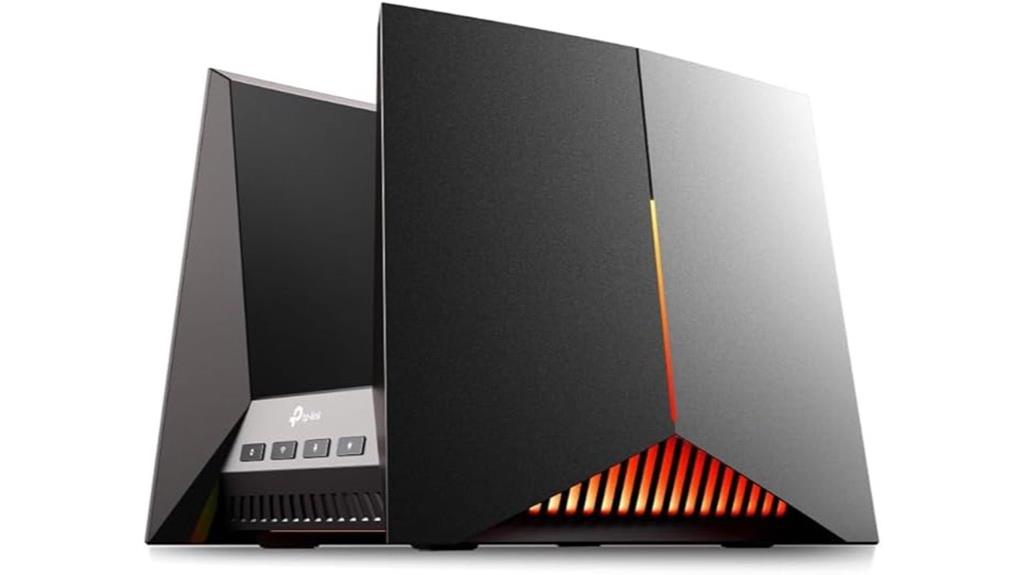
If you’re serious about online gaming and need a router that can handle multiple devices with minimal lag, the TP-Link Archer GE800 is an excellent choice. It offers up to 19 Gbps tri-band Wi-Fi speeds, leveraging Wi-Fi 7’s 320MHz channels and Multi-Link Operation for stronger, interference-free connections. With 12 streams and 8 antennas, coverage is seamless and stable. It features two 10 Gbps ports and four 2.5 Gbps ports for high-speed wired setups. Designed for gamers, it includes dedicated gaming ports, application boost, and server acceleration. Its sleek, RGB-lit design adds a gaming aesthetic, making it perfect for demanding setups.
Best For: gamers and households with multiple high-demand devices seeking ultra-fast, stable Wi-Fi 7 connectivity and low latency for an optimal online gaming experience.
Pros:
- Delivers up to 19 Gbps tri-band Wi-Fi speeds with Wi-Fi 7 technology for exceptional performance
- Supports over 25-30 devices simultaneously with seamless coverage due to 12 streams and 8 antennas
- Features dedicated gaming ports, application boost, and server acceleration for optimized gaming performance
Cons:
- Higher price point around $350 may be a barrier for some users
- Limited web interface functionality and some security features require additional subscriptions
- Range and device stability issues reported by some users, leading to potential dropouts
TP-Link AX5400 WiFi 6 Router (Archer AX73)

The TP-Link AX5400 WiFi 6 Router (Archer AX73) stands out with its impressive 5400 Mbps speeds and advanced WiFi 6 technology, making it an excellent choice for anyone who demands fast, reliable connections for gaming, streaming, and large file transfers. Its 4T4R and HE160 tech on the 5 GHz band support up to 4.8 Gbps, reducing lag and congestion even with multiple devices. Designed for extensive coverage, it features 6 antennas, beamforming, and mesh support via OneMesh. Easy to set up and manage through the Tether app, it also offers robust security and a USB port for media sharing. It’s a solid, high-performance router for demanding home networks.
Best For: households and gamers seeking high-speed, reliable WiFi 6 coverage with extensive range and mesh capabilities.
Pros:
- Delivers up to 5400 Mbps speeds with WiFi 6 technology, supporting multiple devices seamlessly
- Extensive coverage with 6 antennas, beamforming, and mesh support via OneMesh
- Easy setup and management through the Tether app, along with robust security features
Cons:
- Priced around $100, which may be higher than basic routers for casual users
- Large size may not suit small or cluttered spaces
- Advanced features might be overwhelming for users seeking only simple internet access
MSI Radix AXE6600 WiFi 6E Gaming Router
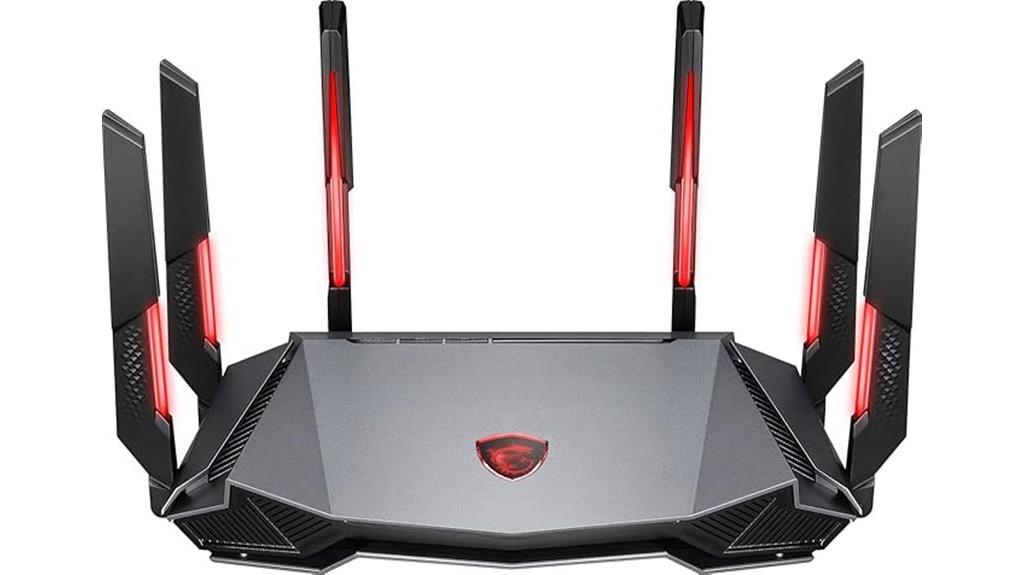
Equipped with WiFi 6E and tri-band support, the MSI Radix AXE6600 is designed for gamers who demand ultra-fast, reliable connections across multiple devices. It offers speeds up to 6.6Gbps and supports eight simultaneous streams, perfect for demanding gaming, streaming, and VR. The router features a powerful 1.8GHz quad-core processor, AI QoS for automatic prioritization, and extensive coverage for large homes, even outdoors. Its sleek design includes Mystic Light RGB, though the lights can’t be turned off. Setup is simple with the MSI Router app, making this router a top choice for high-performance, lag-free gaming across multiple devices.
Best For: gamers, streamers, and large households seeking high-speed, reliable WiFi 6E coverage for multiple devices and demanding applications.
Pros:
- Supports tri-band WiFi 6E with speeds up to 6.6Gbps and 8 streams for optimal performance
- Excellent coverage suitable for large homes and outdoor areas, reducing the need for extenders
- User-friendly setup via MSI Router app with advanced options for tech-savvy users
Cons:
- Issues with Access Point mode and static LAN IP settings not being properly honored even after firmware updates
- RGB lighting controls are ineffective, with no way to turn off lights through app or web interface
- Some limitations in advanced network configurations, such as lack of default gateway options for remote management
Tenda WiFi 6 Gaming Router, AX3000 Dual Band Wi-Fi Router
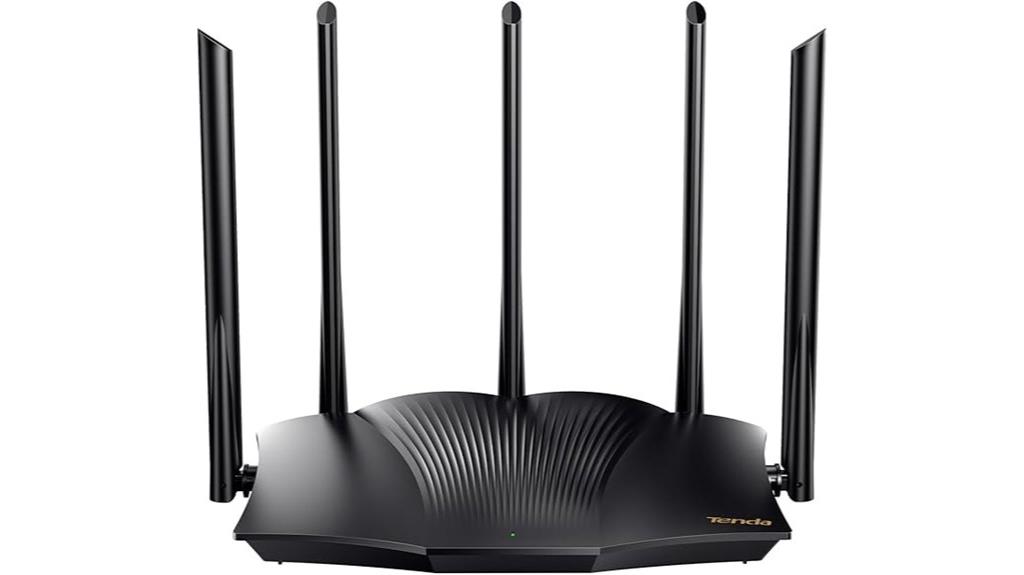
For gamers and streamers seeking seamless, high-speed Wi-Fi throughout large homes, the Tenda RX12 Pro WiFi 6 Gaming Router (AX3000) stands out with its dual-band gigabit connectivity and extensive coverage. It delivers speeds up to 2976Mbps, supported by a powerful 1.7GHz quad-core CPU and five high-gain antennas that guarantee stable, wide-reaching signals. Designed for large spaces, it covers up to 3000 sqft, even outdoor areas. With easy setup via the Tenda app, WPA3 security, and future support for OpenVPN and WireGuard, it offers reliable performance for gaming, streaming, and smart home devices across multiple rooms.
Best For: gamers, streamers, and large households seeking reliable, high-speed Wi-Fi coverage across extensive or multi-story homes.
Pros:
- Offers高速dual-band Wi-Fi up to 2976Mbps with a powerful 1.7GHz quad-core CPU for smooth performance.
- Extensive coverage up to 3000 sqft with five high-gain antennas and signal enhancement modules, ideal for large homes and outdoor areas.
- Easy setup via mobile app or web interface, plus robust security features including WPA3, parental controls, and VPN support.
Cons:
- Limited to functioning as a router; requires a separate modem for internet access.
- Mesh expansion is restricted to other RX12 Pro units, with no compatibility with third-party systems.
- Firmware updates for advanced VPN features like OpenVPN and WireGuard are pending, and the interface may occasionally become unresponsive.
TP-Link Tri-Band WiFi 7 Router (Archer BE550)
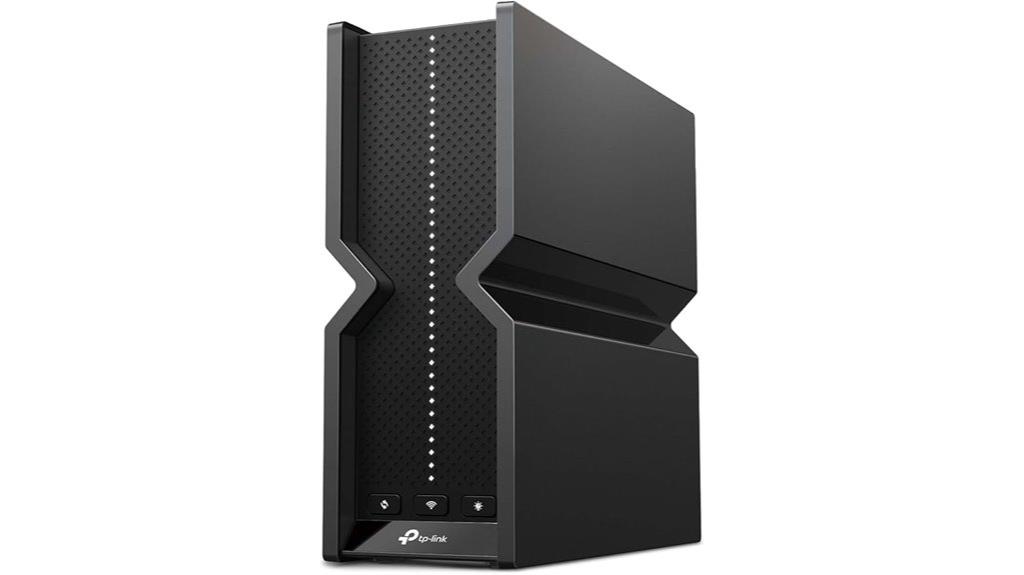
If you’re serious about high-performance gaming or streaming, the TP-Link Archer BE550 offers tri-band WiFi 7 with speeds up to 9.2 Gbps, making it an ideal choice for those who demand blazing-fast, reliable connections. It features six internal antennas and Beamforming technology for stability, supporting Multi-Link Operation (MLO) across 2.4 GHz, 5 GHz, and 6 GHz bands. With full 2.5 Gbps WAN and LAN ports, it’s future-proofed for ultra-fast downloads, 4K/8K streaming, and gaming. Its coverage extends up to 2,000 sq ft, and EasyMesh support simplifies expanding your network seamlessly. This router is built for power users who want top-tier performance.
Best For: power users who require ultra-fast, reliable WiFi 7 connections for gaming, streaming, and extensive smart home setups.
Pros:
- Supports tri-band WiFi 7 with combined speeds up to 9.2 Gbps for optimal performance.
- Equipped with six internal antennas and Beamforming for stable, high-capacity connections.
- Full 2.5 Gbps WAN and LAN ports ensure future-proofing and high-speed wired connections.
Cons:
- High cost may be prohibitive for casual or budget-conscious users.
- Setup and configuration could be complex for users unfamiliar with advanced networking features.
- Limited coverage beyond 2,000 sq ft might require additional extenders for larger homes.
ASUS ROG Rapture GT6 Tri-Band WiFi 6 Gaming Router
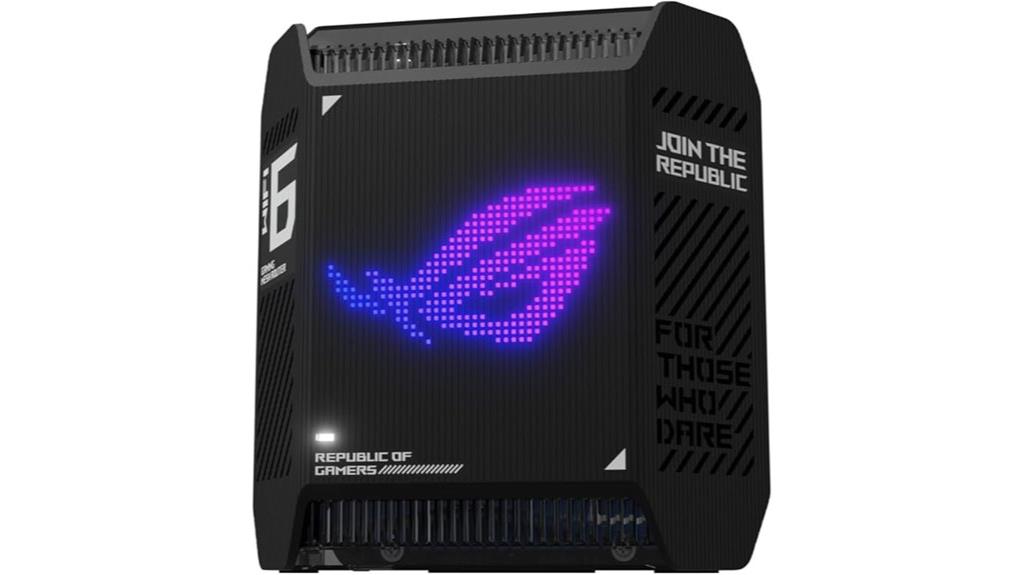
The ASUS ROG Rapture GT6 Tri-Band WiFi 6 Gaming Router stands out as an ideal choice for serious gamers and large households seeking ultra-fast, reliable internet throughout extensive spaces. With speeds up to 10,000 Mbps via dedicated backhaul and 160 MHz channels, it handles multiple devices effortlessly. Its nine antennas and ASUS RangeBoost Plus technology guarantee coverage up to 5,800 square feet. The router features a 2.5 Gbps WAN port, advanced game acceleration, and lifetime security with AiProtection. Supporting WiFi 6, it offers improved capacity and efficiency. Whether gaming or streaming across a large home, the GT6 delivers stable, high-speed connections to minimize lag and boost your experience.
Best For: gamers and large households seeking ultra-fast, reliable WiFi coverage over extensive areas with advanced network customization options.
Pros:
- Delivers extremely high speeds up to 10,000 Mbps and extensive coverage up to 5,800 sq ft with mesh nodes
- Supports WiFi 6 for improved capacity, efficiency, and future-proofing
- Features comprehensive security via AiProtection and ASUS Instant Guard for remote access
Cons:
- Setup and stability may require manual adjustments, especially with mesh nodes and feature toggling
- Disabling certain features like MU-MIMO and beamforming can improve stability but reduces some functionality
- Some issues with mesh node switching and link quality in complex environments despite firmware updates
TP-Link AX3000 Wi-Fi 6 Router Archer AX55

The TP-Link AX3000 Wi-Fi 6 Router Archer AX55 stands out for gamers seeking fast, reliable connections across their entire home, thanks to its next-generation Gigabit Wi-Fi 6 speeds and smart beamforming technology. It delivers up to 2402 Mbps on 5 GHz and 574 Mbps on 2.4 GHz bands, ensuring smooth streaming, quick downloads, and low-lag gaming. Four high-gain antennas and beamforming extend coverage indoors and outdoors, while OFDMA reduces latency for multiple devices. Easy to set up via the TP-Link TETHER app, it also supports secure VPN connections, parental controls, and compatibility with major ISPs, making it a versatile choice for seamless gaming experiences.
Best For: gamers and households seeking fast, reliable Wi-Fi 6 coverage with easy setup and comprehensive security features.
Pros:
- Supports next-generation Wi-Fi 6 speeds up to 2402 Mbps on 5 GHz and 574 Mbps on 2.4 GHz bands for smooth streaming and gaming
- Four high-gain antennas with Beamforming and OFDMA technology ensure broad, strong coverage indoors and outdoors
- Compatible with major ISPs and offers easy setup via TP-Link TETHER app, with built-in security, parental controls, and VPN support
Cons:
- Wired Ethernet speeds may be limited to around 800 Mbps, slightly below the maximum wired potential
- Advanced configuration options may be complex for some users unfamiliar with network settings
- App lacks integrated speed testing, requiring additional tools for performance verification
Factors to Consider When Choosing Gaming Routers
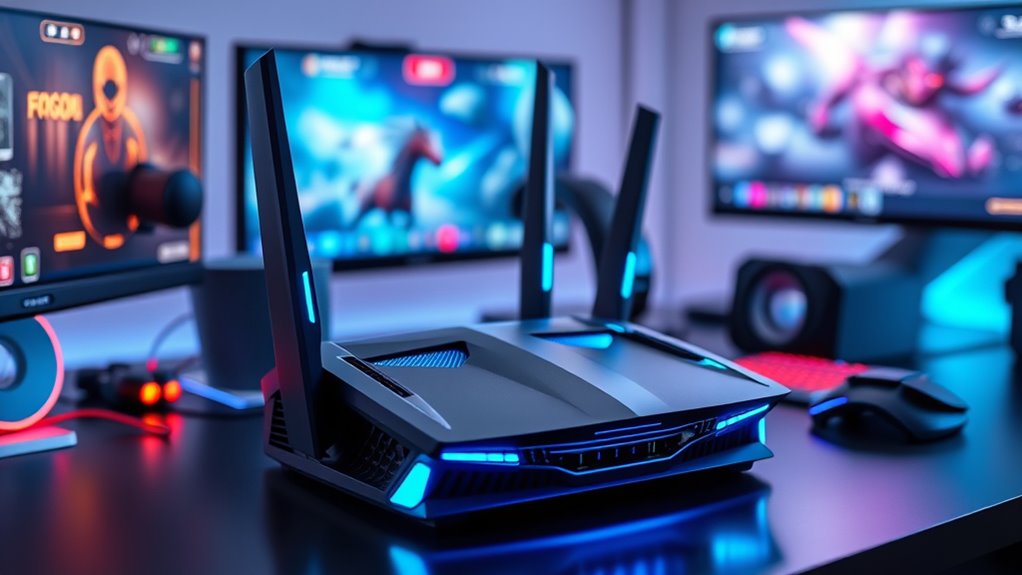
When choosing a gaming router, I focus on speed and bandwidth to keep lag at bay, while coverage and placement ensure a strong signal throughout my space. I also look for gaming-specific features like low latency modes and quality of service, along with security measures to protect my setup. Finally, compatibility and future-proofing help me pick a router that stays relevant as my gaming needs evolve.
Speed and Bandwidth Needs
Choosing a gaming router that meets your speed and bandwidth needs is vital for smooth gameplay and streaming. Modern high-speed routers support WiFi 6 or WiFi 7, delivering speeds from 1.8 Gbps to over 19 Gbps for peak performance. Your bandwidth needs depend on how many devices you have and what activities you do; for example, 4K streaming and online gaming typically require 50 Mbps or more per device. Multi-gig ports (2.5 Gbps, 5 Gbps, or 10 Gbps) are essential for wired connections, matching wireless speeds and preventing bottlenecks. Technologies like OFDMA and MU-MIMO boost capacity and reduce latency by allowing multiple devices to transmit simultaneously. To guarantee lag-free gaming, pick a router supporting speeds at least two to three times your internet plan’s maximum download rate.
Coverage and Placement Tips
Positioning your gaming router correctly can make a significant difference in signal strength and coverage. I recommend placing it in a central, elevated spot, preferably near the ceiling, to ensure even coverage and reduce dead zones. Keep the router away from thick walls, metal objects, and electronic devices that can cause interference and weaken the Wi-Fi signal. Using high-gain antennas oriented vertically helps boost coverage and signal quality. If you have a larger or multi-story home, consider mesh systems or additional extenders for seamless connectivity. Regularly testing signal strength in different areas helps identify weak spots and optimize placement for consistent gaming performance. Proper placement ensures you get the most out of your router’s capabilities and minimizes lag during gameplay.
Gaming-Specific Features
Gaming-specific routers are designed to enhance your online experience by prioritizing gaming traffic and reducing lag. They often feature Quality of Service (QoS) settings that prioritize game data, minimizing latency during intense sessions. Many also include customizable game modes or profiles tailored to specific titles or platforms, optimizing network performance for each. Advanced routers support ping optimization tools, server filtering, and geo-fencing, which help maintain stable, low-latency connections. High-performance models come with multi-gigabit ports and Multi-Link Operation (MLO), enabling multiple high-speed data streams simultaneously. Some even have dedicated gaming ports or hardware acceleration, ensuring consistent, low-latency connections even with multiple devices connected. These features are essential for a smooth, lag-free gaming experience.
Security and Parental Controls
When selecting a gaming router, security and parental controls are vital to protect your network and manage access effectively. Modern routers offer features like WPA3 encryption, VPN support, and built-in firewalls to safeguard your gaming traffic and personal data from cyber threats. Some models also include IoT device protection and automatic security scans, preventing unauthorized access and identifying vulnerabilities. Parental controls allow you to monitor internet activity, set time limits, and block specific websites or services, giving you control over your family’s online experience. Regular firmware updates are indispensable, as they patch security flaws and improve overall protection against emerging threats. Prioritizing these features ensures a safer, more secure gaming environment for everyone.
Compatibility and Future-Proofing
Choosing a gaming router that is future-proof means guaranteeing it supports the latest Wi-Fi standards like Wi-Fi 6, Wi-Fi 6E, or Wi-Fi 7, which will keep your network compatible with upcoming devices. Look for routers with Multi-Link Operation (MLO) and advanced modulation features to ensure seamless performance with future Wi-Fi 7 gadgets. It’s also smart to choose a model that supports mesh networking and easy expansion, allowing your network to grow as your needs evolve. Multi-gig ports (2.5 Gbps or higher) prepare you for faster internet plans and wired upgrades. Finally, verify that the manufacturer offers firmware updates and security patches, which extend your router’s lifespan and guarantee it stays relevant with emerging standards and features.
Frequently Asked Questions
How Does Router Placement Affect Gaming Performance?
Router placement really impacts gaming performance because a well-placed router guarantees a stronger, more stable signal. I always try to put mine in a central spot, elevated and free from obstructions like walls or furniture. This minimizes lag and reduces connection drops. When your router is in the right spot, your gaming experience becomes smoother, with faster response times and fewer interruptions, giving you that competitive edge.
Can Firmware Updates Improve Gaming Speeds and Reduce Lag?
Yes, firmware updates can definitely improve gaming speeds and reduce lag. I make it a habit to check for updates regularly because manufacturers often release improvements that optimize performance and fix bugs. Updating firmware can enhance your router’s stability, security, and overall efficiency, which directly benefits your gaming experience. So, I recommend keeping your router’s firmware current to enjoy smoother gameplay and lower latency.
Do Gaming Routers Support Multiple Devices Simultaneously?
Think of a gaming router like a busy highway; it needs to handle multiple cars without traffic jams. I’ve found that most gaming routers support multiple devices at once, thanks to advanced technologies like MU-MIMO. This means your console, PC, and phones can all stream and game smoothly. So, yes, modern gaming routers are built to support several devices simultaneously, ensuring everyone gets a fair lane to enjoy their digital adventures.
What Is the Ideal Bandwidth Allocation for Gaming?
The ideal bandwidth allocation for gaming depends on your internet plan and the number of devices connected. I recommend prioritizing your gaming device using Quality of Service (QoS) settings, guaranteeing it gets enough bandwidth—usually at least 25 Mbps for smooth gameplay. Avoid bandwidth hogs during gaming sessions, and keep latency low. Balancing your network helps prevent lag and ensures a seamless gaming experience.
How Do Advanced Security Features Impact Gaming Latency?
Think of advanced security features as a double-edged sword; they protect your game data but can sometimes slow everything down. When enabled, they add extra steps or checks, which may introduce slight latency. However, with modern routers, these features are optimized to minimize impact. I’ve found that a good balance keeps my network safe without sacrificing the fast, lag-free gaming experience I crave.
Conclusion
Choosing the right gaming router is like finding the perfect gear for a battle—every piece matters. With top options like the TP-Link AXE5400 and ASUS ROG Rapture GT-AX11000 Pro, you can conquer lag and enjoy seamless gameplay. Remember, a great router is your trusted sidekick, turning a good game into a legendary one. Gear up wisely, and let your gaming victory be just a click away!
